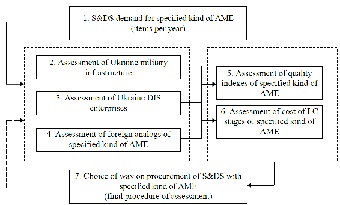Formation of base data list and content for determining of the ways for military teams procurement with armament
Abstract
Maintenance of samples of weapons is carried out at the stages of their life cycle and is carried out on the basis of coordination of actions of the customer and the consumer with a wide range of organizations from the main developer to the co-executors, which does not exclude the occurrence of conflict situations. This leads to the problem of implementing the optimal synthesis of such a complex system and does not allow to direct efforts to achieve the extremum of the target function of the system as a whole. Therefore, the emergence of such a problem and the existing conflicts in the process of determining the means of providing arms to military formations is considered as a complex organizational system, and the difficulties of direct solution of the problem of optimal synthesis in this case are related to: the interconnections of a complex system (between systems of the lower level and elements of the system); limited programming abilities; the construction of a mathematical model, etc.; and cause the need to find solutions to this problem.
The methods developed at present allow analytically to calculate the technical perfection of the weapons samples that are considered for providing military formations, as investigated when choosing for procurement or development. Such tasks are deterministic, but, considering costs at all stages of the life cycle, there may be stochastic (probable ones) that can be solved by expert methods. At present, the list and content of the source data when choosing ways of providing weapons are not defined at all stages. Thus, having them strictly non-formalized, the statement of the problem of synthesis is carried out under conditions of uncertainty, which in most cases is solved by heuristic methods, which in turn allows elements of subjectivity.
Having determined the list and content of the initial data, it is possible to pre-implement the calculations in cost form (strictly mathematical) in the form of expenses, having carried out the projection of expenditures at the stage of the weapon’s life cycle, and such a list to be chosen according to the criterion of the problem of synthesis, while defining the criteria of the restrictions, and to use these data for assessing the quality of this type of weapons and the cost of the stages of their life cycle. Also, in case of incomplete receipt of such data in cost form, with their partial, such an assessment will allow to determine between the corresponding methods when solving the problem of choosing ways of providing arms in the medium term. Even if this method is not analytical, then the relevant statistics will help to reduce the degree of uncertainty and subjectivism when choosing ways to provide armed skills by expert means.
Downloads
References
Borohvostov, I. V., Bilokur, M.O. (2018). Determination of the criteria and methods for assessment of the ways on procurement of the military teams with armament and military equipment. Weapons and Military Equipment. № 3. P. 3 – 8. [in Ukrainian]
Burenok, V. M., Pogrebnyak, R. N., Skotnikov, A. P. (2010). Methodology on grounding of the development prospects of general intention means for militant actions. Moscow. “Mashinostroyenie” 368 p. [in Russian]
Semenov, S. S., Kharchevв, V. N., Ioffin, A. I. (2004). Armament and military technic items technical level assessment. Moscow. “Radio &Communication”, 552 p. [in Russian]
Nor, P. I. (2016). Methodology of complex comparative assessment of armament and military equipment items. Weapons and Military Equipment. Issue 3(11). P. 14–18. [in Ukrainian]
Chepkov, I. B., Zubarev V. V., Borohvostov V. K. etc. (2018). Armament theory. Scientific-technical problems and tasks. Vol. 6. Military-economical analysis of armament and military equipment life cycle: theoretical and methodological-bases: monograph. Kyiv: Dmytro Burago’s Publishing House. 475 p. [in Ukrainian]

Abstract views: 542 PDF Downloads: 301
Copyright (c) 2019 Igor Borohvostov , Nikolai Bilokur, Yevgeny Kolotukhin , Ivan Tkach

This work is licensed under a Creative Commons Attribution 4.0 International License.
The authors agree with the following conditions:
1. Authors retain copyright and grant the journal right of first publication (Download agreement) with the work simultaneously licensed under a Creative Commons Attribution License that allows others to share the work with an acknowledgment of the work's authorship and initial publication in this journal.
2. Authors have the right to complete individual additional agreements for the non-exclusive spreading of the journal’s published version of the work (for example, to post work in the electronic repository of the institution or to publish it as part of a monograph), with the reference to the first publication of the work in this journal.
3. Journal’s politics allows and encourages the placement on the Internet (for example, in the repositories of institutions, personal websites, SSRN, ResearchGate, MPRA, SSOAR, etc.) manuscript of the work by the authors, before and during the process of viewing it by this journal, because it can lead to a productive research discussion and positively affect the efficiency and dynamics of citing the published work (see The Effect of Open Access).















